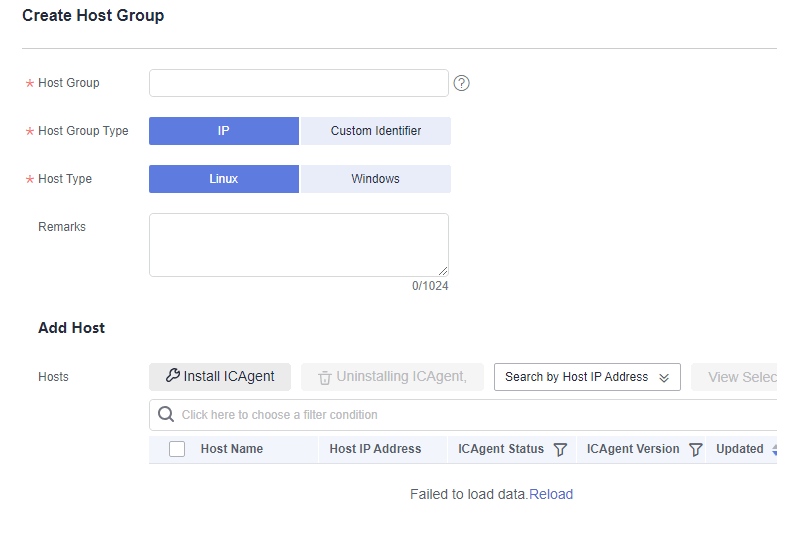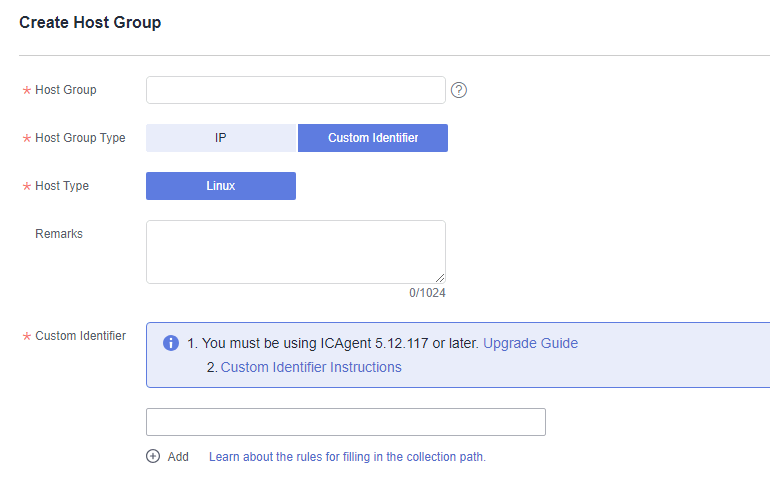Managing Host Groups
Host groups allow you to configure host log ingestion efficiently. You can sort multiple hosts to a host group and associate the host group with log ingestion configurations. The ingestion configurations will be applied to all the hosts in the host group, saving you the trouble of configuring the hosts individually.
- When there is a new host, simply add it to a host group and the host will automatically inherit the log ingestion configurations associated with the host group.
- You can also use host groups to modify the log collection paths for multiple hosts at one go.
Creating a Host Group (IP Address)
- Log in to the LTS console, and choose Host Management in the navigation pane on the left. On the displayed page, click Create Host Group in the upper right corner.
- In the displayed slide-out panel, enter a host group name, select IP for Host Group Type, and select a host OS (Linux or Windows).
Figure 1 Creating an IP address host group

- In the host list, select one or more hosts to add to the group and click OK.
- You can filter hosts by host name or host IP address. You can also click
 and enter multiple host IP addresses in the displayed search box to search for matches.
and enter multiple host IP addresses in the displayed search box to search for matches. - If your desired hosts are not in the list, click Install ICAgent. On the displayed page, install ICAgent on the hosts as prompted. For details, see Installing ICAgent (Intra-Region Hosts).
- You can filter hosts by host name or host IP address. You can also click
Creating a Host Group (Custom Identifier)
- On the Host Management page, click Create Host Group in the upper right corner.
- In the displayed slide-out panel, enter a host group name, select Custom Identifier for Host Group Type, and select a host OS (Linux).
Figure 2 Creating a custom identifier host group


You can click Learn about the rules for filling in the collection path to learn how to configure paths.
- Click
 to add a custom identifier.
to add a custom identifier.

Up to 10 custom identifiers can be added.
- Click OK.
- Run the following commands to create the custom_tag file:
- Run the cd /opt/cloud command. In the cloud directory, run the mkdir lts command to create the lts directory.
- Run the chmod 750 lts command to modify the permission on the lts directory.
- Run the touch custom_tag command in the lts directory to create the custom_tag file.
- Run the chmod 640 custom_tag;vi custom_tag command to modify the custom_tag permission and open the file.
- Press i to enter the insert mode, enter a custom identifier, press Esc, enter :wq!, save the modification and exit.

After 5, you can use either of the following methods to add hosts to a custom host group:
Method 1 (recommended):
Linux
In the custom_tag file of the /opt/cloud/lts directory on the host, view the host identifier and add it to the custom host group identifiers to add the host to the host group. For example, in the custom_tag file of the /opt/cloud/lts directory on the host, the identifier of the host is test1, and the custom identifier of the host group is test1. That is, the host is added to the host group.
Method 2:
Linux
- To add a host to a host group, add the custom host group identifier to the custom_tag file in the /opt/cloud/lts directory on the host. For example, if the custom identifier of the host group is test, enter test in the custom_tag file to add the host to the host group.
- If multiple custom identifiers are added, enter any custom identifier in the custom_tag file of the /opt/cloud/lts directory on the host to add the host to the host group.
Modifying a Host Group
You can change the name of a host group, add hosts to or remove hosts from a host group, or associate a host group with log ingestion configurations.
|
Operation |
Procedure |
|---|---|
|
Changing a host group name |
|
|
Adding hosts to a host group |
Method 1:
Method 2:
|
|
Removing a host from a host group |
NOTE:
This operation is not supported for hosts in the custom identifier host group. |
|
Uninstalling ICAgent from a host |
|
|
Removing hosts from a host group |
|
|
Associating a host group with an ingestion configuration |
|
|
Disassociating a host group from an ingestion configuration |
|
|
Disassociating a host group from multiple ingestion configurations |
|
|
Copying a host group ID |
Hover your cursor over a host group name to copy the host group ID. |
Deleting Host Groups
Deleting a single host group
- On the Host Management page, the Host Groups tab is displayed by default.
- On the Host Groups tab, click the deletion icon in the Operation column of the row containing the target host group.
Figure 3 Deleting a host group

- In the displayed dialog box, click OK.
Deleting host groups in batches
- On the Host Groups tab, select multiple host groups to be deleted and click Delete above the list.
- In the displayed dialog box, click OK.
Feedback
Was this page helpful?
Provide feedbackThank you very much for your feedback. We will continue working to improve the documentation.See the reply and handling status in My Cloud VOC.
For any further questions, feel free to contact us through the chatbot.
Chatbot








